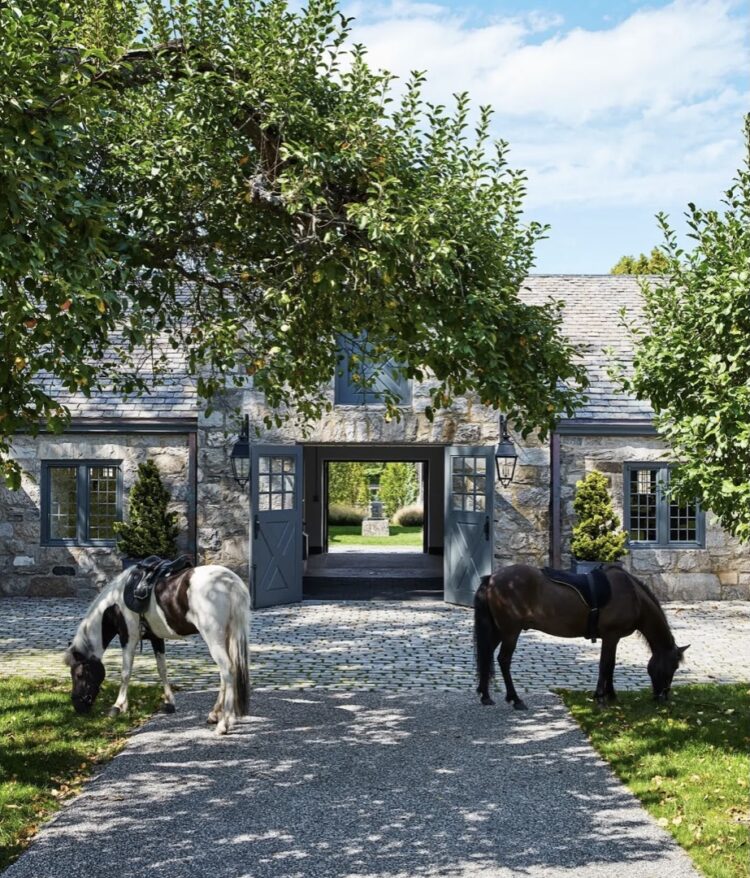The past 10 years have brought a plethora of home design trends —some helpful, some less so. After the pandemic, will architects design every entryway with a built-in handwashing station? Sorry, no. Will we ever travel the same way again? (Not entirely.) Are open-plan homes history? (Some architects say yes; we’ll believe it when we see it.) And, come 2030, will we farewell burnt dinners forever? (Yes, the oven of the future will basically give you microwave convenience with restaurant quality and ultimate control). Here’s how travel, dining, homes and decorating will change post-pandemic – for the better.
What might the next decade offer up? How will homes change, we ask.

Our relationship with nature has been reset; 82% of people say they value nature more than before the pandemic. Landscape design by Rees Roberts + Partners for country estate by AD100 designer Sheila Bridges. Photo: Frank Frances for ArchitecturalDigest.com
Top 9 Design Trends of the Next Decade:
Your New Home Will Make You Happy
Will our kitchen, dining, and living spaces still blur together, or will walls make a comeback? Will generations increasingly begin living under the same roof? Homes will connect more with nature, while minimalist decor and open-plan living will be shown the door.
1. Calm, Zen, Layered, Green, Natural Environments.
The definition of home is changing. It’s beyond our individual homes and rear gardens — it’s the streets in front of us, the communities, and the neighbours that we’ve spent years living next to but never spoken to. Our relationship with nature has been reset: 82% of people now say they value nature more than before the pandemic, according to research. If lockdowns have taught people anything, it’s the benefit of the natural world on their homes, happiness and health. Read more, ‘The New Comfort: What Does “Home” Mean in 2021.”
Letting in and filtering sun and light with serene spaces, involving great connections to outdoor spaces, no matter the size.
2. The Open Plan Backlash.
Design over the next few years will reflect our lived experience in 2020/21 when the house became school, office, gym, temple, restaurant, salon, everything. Whereas 10 years ago, everyone wanted open-plan living, the pandemic has left homeowners seeking the privacy of separate rooms. The switch will be reflected in new residential buildings. For homeowners who can’t decide between an open-plan layout or one with separate rooms, there’s a compromise or antidote: steel-and-glass partitions that define interior spaces while maximizing light and transparency. Read more, ‘Why Open Plans Are Actually A Terrible Idea.’
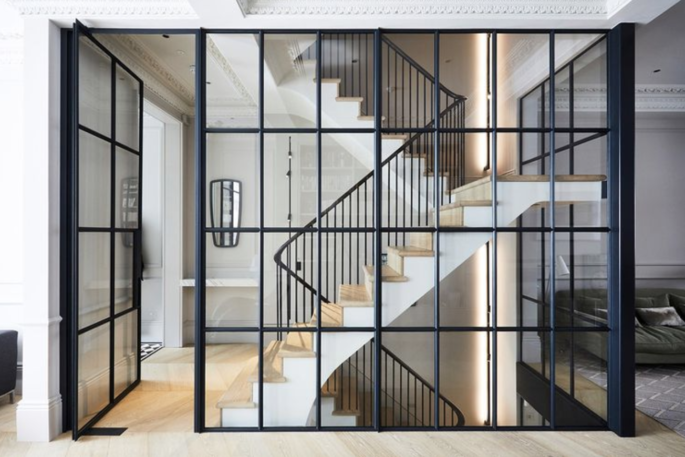
For homeowners who can’t decide between an open-plan layout or separate rooms, there’s a compromise: steel-and-glass doors such as this double-height glass atrium that wraps around an existing staircase, over two main living levels of a London townhouse by Michaelis Boyd design. Photo:Tim Van Cook.
3. Ergonomics Will Take Over The Luxury Furniture Market.
Prolonged periods spent on the same sofa or chair mean beauty will need to meet ergonomics in luxury furniture. “We don’t want to bring our office chair to the dining table, but we need to have the same ergonomics in order not to end up with problems with our backs”, wrote Kate Youde in Financial Times. Furniture will have a double or triple function. Dining tables could have power and data connectivity too. Read more, ‘Top 10 Design Trends For 2021: Meet Your New Home.’
4. Green Design is the New Essential.
Sustainability will be upgraded from ‘nice to have’ to essential in house design, says Gerald Parsonson, founder of New Zealand-based practice Parsonson Architects, in the Financial Times. This will require practical considerations about the use of low carbon materials, their life cycle, carbon outputs, meaning architects might permanently favour materials like timber that lock up carbon rather than generating it. Read more, ‘An Evolution: Trend Report Exploring What’s Next For Design.’
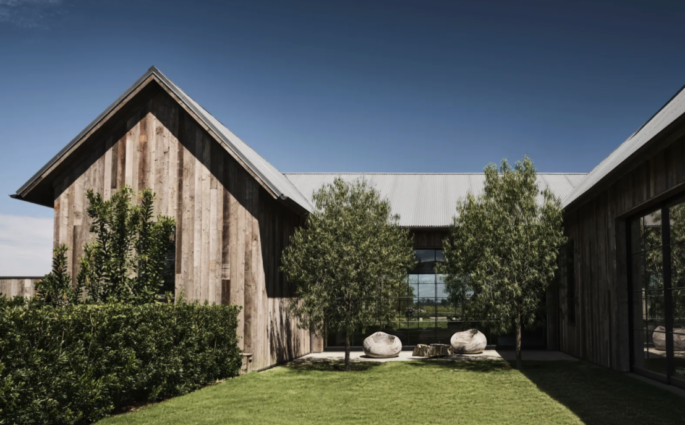
Sustainability will be upgraded from ‘nice to have’ to essential such as the green, soulful timber design of L.A. farmhouse for Hollywood superstar couple, Ashton Kutcher and Mila Kunis. Design by Howard Backen and Vicky Charles. Photo: by Douglas Friedman for ArchietcturalDigest.com
5. The Extended Home.
Working from home — at least for part of the time — looks like it is here to stay. At the same time, the popularity of home schooling has risen sharply. As a result, our homes will continue to adapt.
There are two solutions for the newly space-pressed home: expand or divide.
Brit residential architecture firm, Resi reports in a Financial Times article that searches on its website were up by 95 per cent in 2020 compared with last year, and “home extensions” was their most popular category. Read more, ‘We Can’t Go Back To Normal- How Coronavirus Will Change Home Design.’
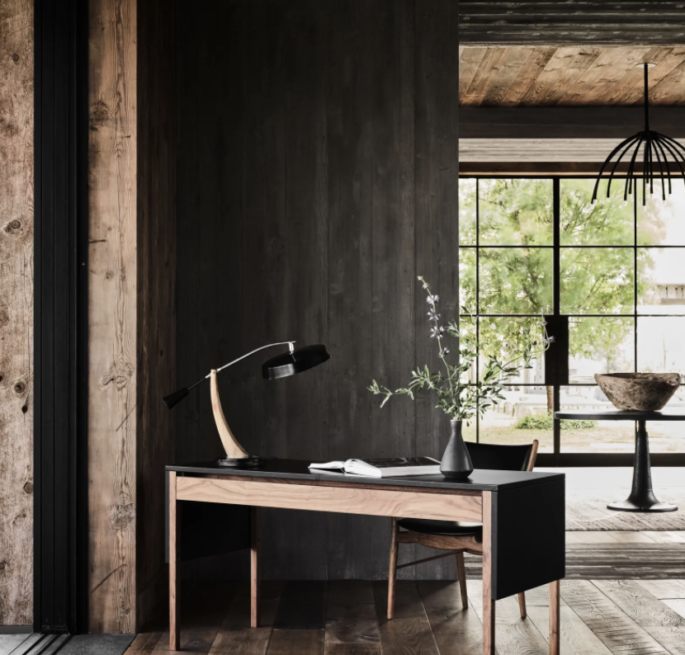
“Home extensions” are one of the most popular categories on residential architectural sites as personal space and a spot to work have never been more paramount. Ashton Kutcher and Mila Kunis’s sustainable home office proves you don’t need an expensive setup. Just somewhere that won’t distract. Photo: by Douglas Friedman for ArchietcturalDigest.com
6. The City Exodus.
The need for space, combined with the flexibility offered by homeworking, is driving people out of cities. In June, views of homes in rural zip codes across the US increased 34 per cent year-on-year, according to Realtor.com in the Financial Times. Savills’ Crispin Holborow, who specialises in selling high-value property in the UK countryside, says there has been a huge leap in sales of country estates priced above £15m, with 22 sold in 2020, compared with just one in 2019. The strongest market since 2006/7. Last year, saw a new demographic of rural buyers, either people who “would have never imagined they might move out of town” or young couples “leapfrogging” the suburban semi.
The aesthetics of rural life will be hard to escape in 2021 given the unstoppable “cottagecore” trend; which is an idealised version of country life –
think shabby chic meets Little Women.
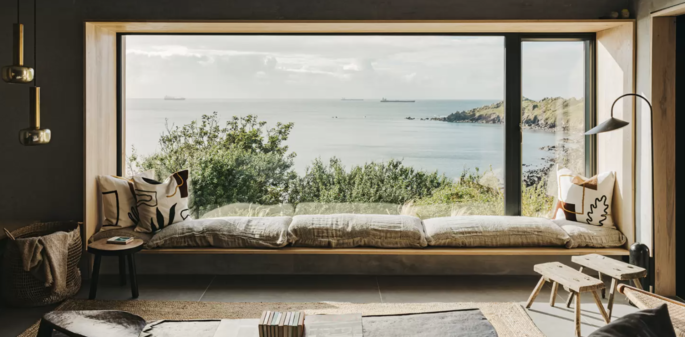
The need for space, combined with the flexibility offered by homeworking, is driving people out of cities. Interior designer Kathryn Tyler renovated this Cornish cottage in a relaxed and contemporary style, opening up the layout and installing vast windows that frame the extraordinary sea views, making for the perfect escape from city life. Image via House and Garden UK.
7. The Energy-Efficient Home.
The reality of running a home 24/7 has made energy efficiency a budget issue as well as an environmental one. It’s hitting people’s chequebooks,” says Vanessa Hale, who heads Strutt & Parker’s annual Housing Futures survey. In 2020 they saw a leap in buyers coveting dull but useful features such as double glazing and smart thermostats, and a sharp rise in the numbers wanting to move into new-builds as a result of their perceived eco-features. The pandemic precipitated such a shift in thinking. In many homes, one part of it is freezing, and the other side is boiling hot. This minor irritant became an obstacle during lockdown, as many households needed to deploy every room available.
8. Self-Reliant Living.
When the first global lockdowns occurred last year, Google searches for “how to grow vegetables” hit record highs. The grow-your-own mentality has stuck says Harriet Fitch Little in the Financial Times.
More than one year on, there is still a noticeable boost in people getting into growing food at home and continuing due to the pandemic.
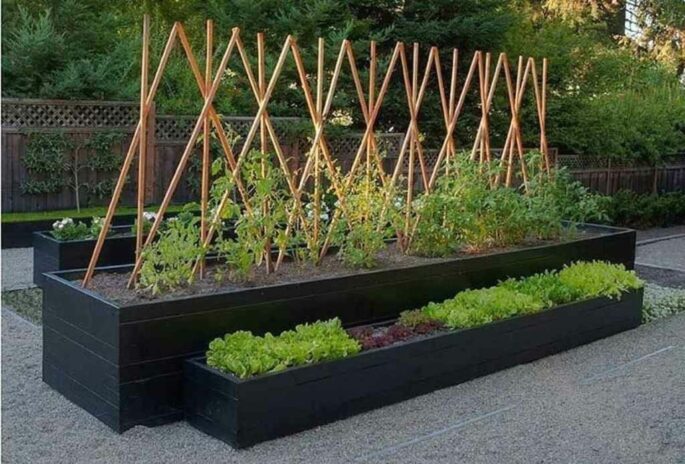
Google searches for “how to grow vegetables” has hit record highs. Raised beds or large containers are more moisture-rich and usually better draining than open ground. Image via Gardenista.com
9. The Big Question.
Ultimately, the big question when it comes to post-Covid homes is this: how can we adapt so that we are better prepared for the dreaded “next time”? Designing very specifically for Covid misses the point of resilience because tomorrow’s Covid might not be Covid at all. We need to design homes — and communities — in such a way that they are resilient to all threats: a different pandemic, climate change or something as yet utterly unknown. Read more, ’21 Updates For 2021 Shaped By The Pandemic.’
What matters is building a general resilience to the unknown challenges of the future.
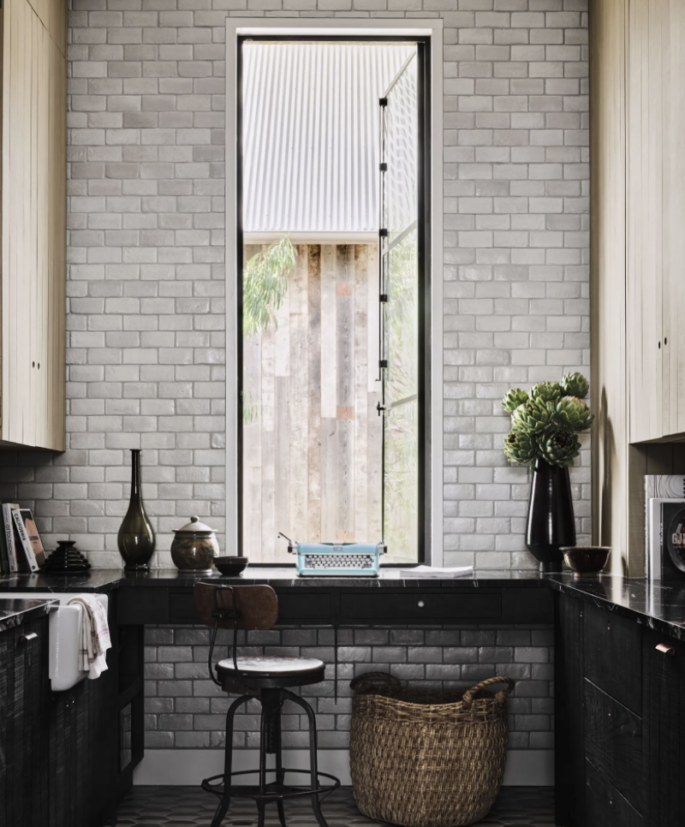
The picturesque pantry at Ashton Kutcher and Mila Kunis’s Sustainable L.A. Farmhouse. The superstar couple tapped Howard Backen and Vicky Charles to craft a soulful home at one with the land. Photography by Douglas Friedman for ArchietcturalDigest.com
10 Food Trends For The Next Decade:
Family Dinners, Less Booze and More
Here, the best bets on how we’ll eat, drink, farm and find comfort at the table in the years to come according to a Wall Street Journal article on the subject. Odds are we’ll reduce food waste and alcohol consumption, care more about the people who feed us, and open up the bill of fare to a wider range of cuisines and perspectives.
And it will all be very soft and cosy.
1. Booze will lose traction.
Alcohol consumption has been falling in the U.S. for years (quarantine blips and binges notwithstanding). A more mindful, health-conscious generation of drinkers will continue to drive a shift away from Martinis and Manhattans toward low- and no-alcohol choices. Think aperitif culture, adaptogen-infused mocktails, non-alcoholic spirits, session beers, and low-ABV wines.
2. Families will eat—and cook—together more often.
A silver lining of pandemic lockdown: It enabled many families to eat together nightly, with kids pitching in with the cooking out of necessity. As remote work becomes more prevalent, the ritual will continue, advancing a whole generation’s kitchen skills for the long haul. Media company America’s Test Kitchen reports sales of its kids’ cookbooks have doubled in recent months with many more titles focused on young cooks now in the pipeline.
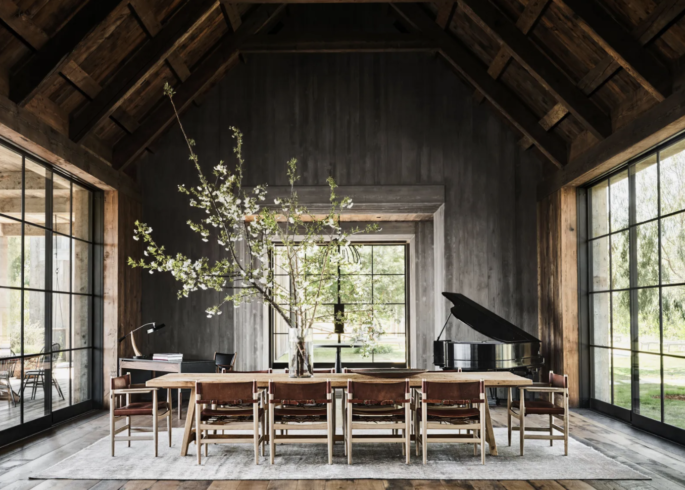
Ashton Kutcher and Mila Kunis’s Sustainable L.A. Farmhouse. The superstar couple tapped Howard Backen and Vicky Charles to craft a soulful home at one with the land. Photography by Douglas Friedman for ArchietcturalDigest.com
3. Regionalism will heat up.
Eurocentric dining has been on the wane in America, making way for different culinary perspectives. Diners will dig even further into hyperspecific food concepts, those driven by authentic personal narrative and/or a highly particular cultural context. Harbingers: the restaurant Benne on Eagle in Asheville, N.C., which celebrates African influences on Appalachian cuisine; or the recent pop-up dinners put on by New York’s Junzi Kitchen, where chef Lucas Sin collaborates with fellow chefs to cook the food of the Chinese diaspora.
4. Restaurants will Wear Many Hats.
All-day cafes were just the start: Following on Covid-era business pivots, restaurants will continue to find new ways to serve their communities, extending their purview beyond sit-down dining to offerings like meal kits, cooking classes, wine clubs and food retail. Marguerite Mariscal, CEO of the restaurant group Momofuku, sees chefs playing a curator role, as valued by diners for assembling a take-home box of artisanal groceries and house-made products as for cooking a hot meal.
5. Zero-Waste will be All-Important.
Waste-consciousness will go mainstream, with consumers demanding better biodegradable delivery packaging, composting at home and buying from burgeoning waste-reducing grocers such as Imperfect Foods. Organizations like Zero Foodprint and Rethink will grow, working with restaurants on a larger scale to reduce their carbon footprints and connect extra food with community needs.
6. Plants will Rule.
The shift away from animal protein isn’t a fad but, rather, a far-reaching cultural phenomenon. Meanwhile, Elle Simone, executive director of America’s Test Kitchen, sees a growing interest in actual veggies propelling the plant-centric cuisines of the Middle East and Eastern India into the spotlight.
Plant-based meat and dairy substitutes will improve and proliferate.
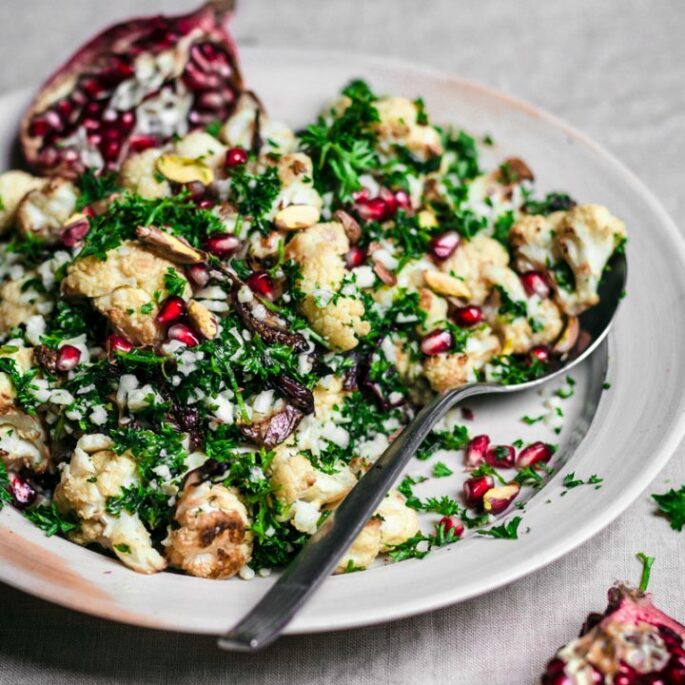
The shift away from animal protein meals isn’t a fad. Ottolenghi’s famed cauliflower and pomegranate salad. Image via ottolenghi.co.uk
7. Heterogeneity will be the New Normal.
Restaurants and food brands will be headed by a more diverse group of chefs, entrepreneurs, and executives than ever before, as consumers and investors awaken to all the talented women and people of color who have been shut out of leadership positions to date.
A proliferation of new flavors and ideas will follow.
8. We’ll Upgrade from ‘Organic’ to ‘Regenerative.’
As the term “organic” continues to be diluted, evolved eaters will instead seek out ingredients labeled “regenerative”: grown and raised using methods that improve the soil, capturing carbon, and encouraging biodiversity. A new Regenerative Organic Certified program, launched in August of this year, will help shoppers identify bona fide products.
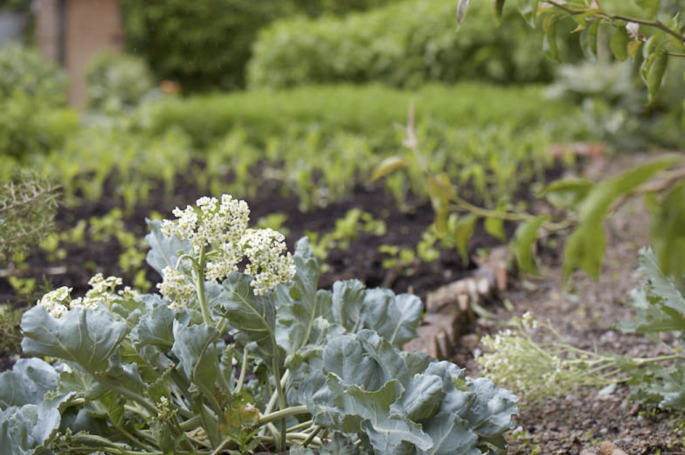
The grow-your-own mentality has stuck. More than one year on, there is still a noticeable boost in people getting into growing food at home and continuing due to the pandemic. Photo by Britt Willoughby Dyer via Gardenista.com
9. Ethical Employment Practices will take Root.
The farm-to-table revolution was all about the ethics surrounding how food is grown. Going forward, consumers will seek out restaurants and brands that care as much about their people as their ingredients. Employee-owned businesses such as the King Arthur Baking Company and Bob’s Red Mill Natural Foods will gain cachet; the restaurants that weather the pandemic will increasingly bake a living wage for staff into their business models.
10. Comfort will be the Vibe Du Jour.
Tumultuous times will leave us craving simpler plating, product-driven cooking, and old-school recipes, both at home and in restaurants. Anna Polonsky, the founder of the restaurant design and strategy firm Polonsky and Friends, said she sees tablecloths making a comeback—as in grandmothers’ linens, not ultra-high-end ones—along with rounder edges, cozy fabrics, handmade ceramics, comfortable seating, and softer lighting. Read more, “Are You A Comfort Addict and Utterly Addicted to Indulgence.”
Her take: “In a chaotic world, all one wants is stability.”
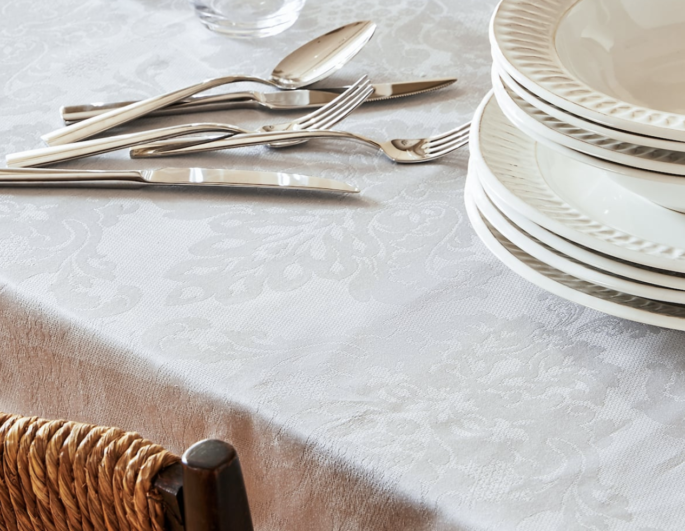
Zara Cotton Jacquard Tablecloth, $59, zarahome.com.au
Big Tech Trends to Come—from Laser Bedside Lamps to Tile TVs and Perfect Meals.
1. Dinner Won’t Get Burnt.
‘’The oven of the future will basically give you microwave convenience with restaurant quality and ultimate control,” said Dave Arnold, inventor and an owner of the Booker and Dax food science development company. You can currently find this tech—“super forced-air convection, steam injection, and very accurate temperature control, all run by incredibly smart microprocessors”—only in ultra-premium equipment. Read more, “Tablescapes: Elevating Dinner at Home During Isolation.”
2. Tile TVs Will Take Over.
Today’s flatscreens will look like off-the-rack suits compared to the bespoke fit of fine-pitch LED tiles. These small, ultra-high-def screens can be seamlessly joined in any configuration. We’ll be able to create something that covers the entire surface area or visual plane of a space much bigger than a 100-inch traditional screen. Imagine that the display in resting-state is wallpaper.
3. A Bright Future is Ahead.
An LED bulb purchased today might not need changing for a decade. By that time illumination might come from lasers, diffused via mirrors or fiber optics. The headlights of some cars such as BMW i8s currently use this enlightening tech, but in time it will go from stark autobahn illumination to the cozy glow of a bedside lamp.
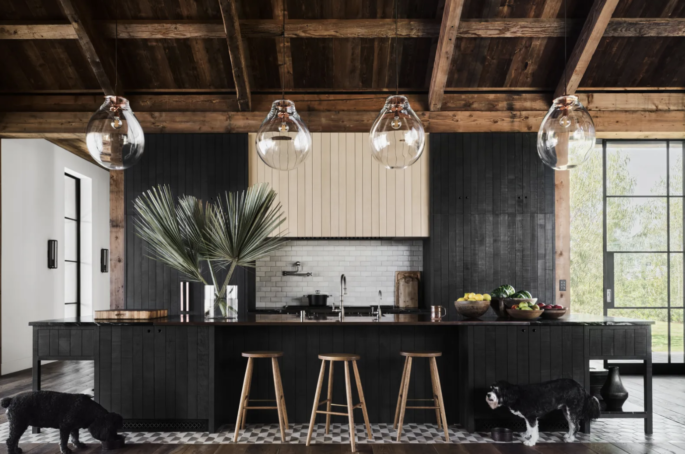
The Devol kitchen at Ashton Kutcher and Mila Kunis’s Sustainable L.A. Farmhouse. The superstar couple tapped Howard Backen and Vicky Charles to craft a soulful home at one with the land. Photography by Douglas Friedman for ArchietcturalDigest.com
How Travel Will Change Post-Pandemic: 10 Expert Predictions
According to research by Andrew Nelson for Wall Street Journal travel is the activity we’ve missed most during the pandemic. But a value shift in the tourism industry is giving rise to a new travel format. Travellers will break with their old mindset, rethink where they want to go and why.
Expect to see more of #travellesstravelsmarter.
1. We’ll Rethink Europe.
Expect a cooling of the romance with Europe’s capitals and new affection for less-crowded cities with strong cultural offerings. People don’t generally miss landmarks, crowded shuttles, and lines and lobbies packed with tourists. “I’d keep an eye on Lyon and Hamburg,” said UK-based travel writer Annie Fitzsimmons, who also predicts a rediscovery of less populated European islands. Among them: Germany’s 24-mile-long island of Sylt, a Teutonic Nantucket.
2. Alaska will beckon.
The pandemic’s searing impact will add a FOMO-like urgency to personal bucket lists. The fresh air appeal of Alaska and Montana will propel them into top spots, thinks Erin Francis-Cummings, CEO of travel data company Destination Analysts.

Alaska beckons. The state is known for its diverse terrain, mountains, wildlife, and beautiful glaciers. Between the months of August to April, you will even be able to spot the Northern Lights. Photo via tourdelust.com
3. As Will Esoteric Food.
Legions more food travellers will seek out the Faroe Islands, predicts TV producer Irene Wong, who travels the globe filming cooking shows. A windy island chain between Scotland and Iceland, it offers a unique cuisine centered on seafood, dairy, and hardy root vegetables.
Any place that’s far and hard to get to is what gets people the most excited.
4. We’ll Eye Quick Check-In.
“In 10 years your face could be your airplane ticket,” said Andrew O’Connor, vice president, airports and borders, at SITA, a Swiss-based information technology provider. Biometric software installed in terminal video cameras will recognize and match your features to your flight while assessing your security and health risks, allowing most travelers to stroll unimpeded from check-in to gate.
5. We’ll Pay for Hygiene.
Germophobic fliers might have the option to pay extra for “Hygiene Class,” a premium cabin that comes with a higher standard of cleanliness, according to Christopher Schaberg, author of “Airportness,” and, coming later this fall, “Grounded: Perpetual Flight…and Then the Pandemic.” Though the air filters shared equally with economy will still do the real work to prevent illness, these higher-priced seats will come with more frequent sanitization and scented sprays.
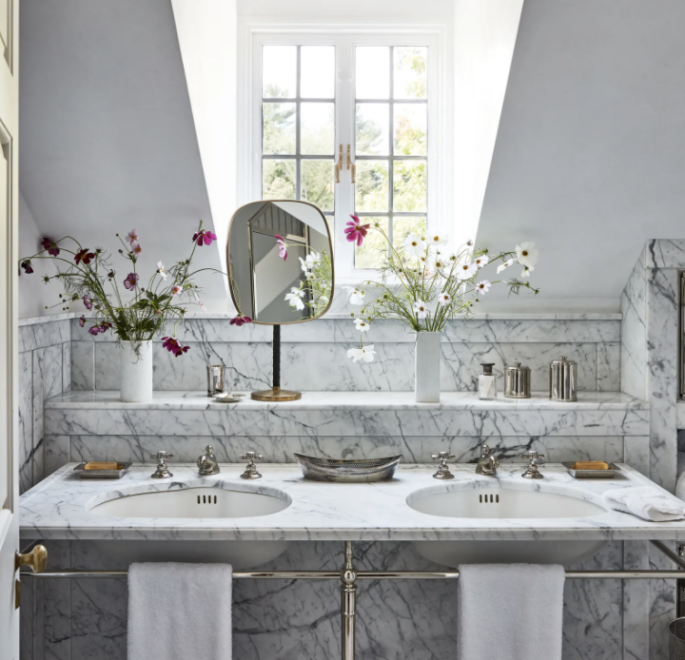
Step Inside An Elegant Country Estate in by AD100 Designer Sheila Bridges. Bridges thoughtfully updates a historic upstate New York State home with verve and aplomb. Photography by Frank Frances for ArchitecturalDigest.com
6. We’ll Cruise the Arctic.
As pleasure ships steam past the pandemic and implement new health protocols, expect to see new destinations. Industry specialists predict massive growth in trips through Canada’s Northwest Passage from passengers eager to view polar bears and other Arctic species before they vanish.
7. We’ll Tip Robot-Maids.
Hotels will become airy places with AI behind the scenes, said Professor Stephani Robson of Cornell School of Hotel Administration. Open lobbies and guest rooms that allow the outside in will be the blueprint, with frump and fuss banished. Also booted: coffee makers and minibars. Anything hard to clean will be suspect in a post-pandemic-era room.
Robots will be present but discreet, vacuuming hallways at 2 a.m.
8. Private Flying Soars Thanks to a New Class of Health-Luxe Travellers.
In a difficult period for commercial airlines, the demand for private flights is skyrocketing as travellers seek safety alongside luxury. Commercial airlines are still seeing passenger traffic 55% below pre-pandemic levels. Aero is a new semi-private luxury jet startup launched by Uber co-founder Garrett Camp. With small 16-seat jets and white-glove service, Aero promises spacious cabins and crowd-free private airports and lounges for a “low-contact getaway.

Booking private jets via an app has become popular in recent months. Photo via CNTraveller.com
9. Hover-Bags will Take Off.
Roam Luggage CEO Larry Lein imagines jets of air replacing the wheels on roller bags. Built-in tracking systems would pair the bag with your phone so the hovering luggage would tail you as you walked.
10. Leopards will Matter Even More.
Peter Fearnhead, CEO of African Parks, a nonprofit that manages 18 national parks and reserves, said countries combining good governance with conservation will become tomorrow’s stars. Two Mr. Fearnhead singles out: Benin and Malawi. The former, in West Africa, is developing Pendjari and W National Parks that feature elephants and lions, while Malawi, in southeastern Africa, is priming reserves with rhinos and leopards.

A cheetah spotting at famed Singita lodge in South Africa, singita.com
The 5 Best Pieces of Design Advice From the Pros
To transform a room quickly, English product and furniture designer Jasper Morrison suggested: “Take everything out and reintroduce the things you actually like, which may lead you to understand your own sense of what a living space should be. A room with an antique wooden chair in it has a very different atmosphere than a room with a modern chair.” (2014)
British architect Lord Norman Foster recommended using light and shadow for a speedy room change. “Light it, open it up to a view, provide a glimpse of the sky, orient it, close it down. For me, space is inseparable from light and shadow.” (2014)
“The best way to layout a room is to take a minute after you’ve had a party to look at where your friends moved the chairs,” said the late American decorator Mario Buatta. “That will give you an idea of the best arrangement.” (2011)
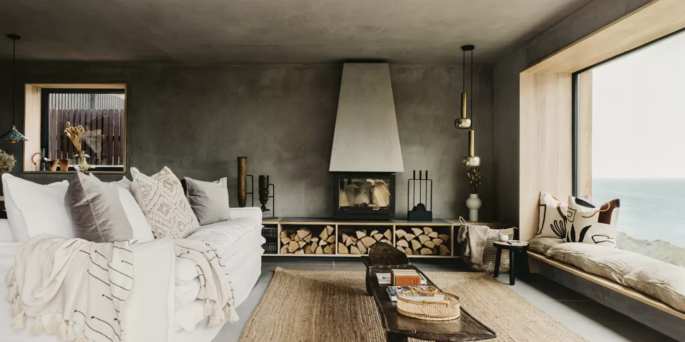
Interior designer Kathryn Tyler’s Cornish cottage offers the perfect amount of clutter and clean, proving you don’t need to throw things out. Just organise smarter. Image via House and Garden UK.
Chicago designer Kate Taylor made the most of a modest-sized antique rug by first laying a simple, inexpensive sisal from Pottery Barn as a large base. She then layered the vintage rug on top. “Even at a smaller scale it provided the visual interest and warmth the client was looking for,” she said. (2019)
“You don’t have to throw out stuff, when you move into a small space,” says interior designer, Perry Sayles. “You need to group and have a place for [the things]. You feel clutter when there’s no open table space. You don’t want all your surfaces covered.” (2020)
“Invisible fences are not just for backyards. I have installed invisible fencing within some of my clients’ homes,” said New York interior designer Phillip Thomas. “It eliminates the need for gates and other cumbersome or unattractive barriers.” (2020) Read more, ‘What Home Improvements Will Add Value To Your Home.’
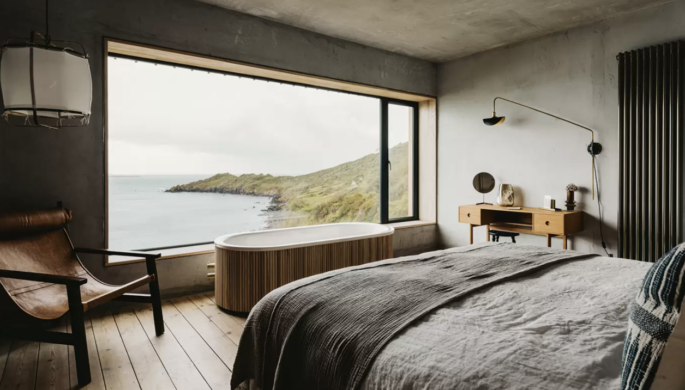
Space is most certainly inseparable from light and shadow at interior designer Kathryn Tyler’s Cornish cottage. Image via House and Garden UK.
Parts of this article are excerpts from Financial Times and Wall Street Journal.

